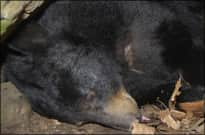Arkansas’s Bear Harvest Continues to be Strong
OutdoorHub 03.01.12

Arkansas’s bear harvest continues to be strong. Hunters harvested more than 400 bears during the 2011-12. Last year, hunters harvested more 450 bears. During the 2009-10 season, hunters harvested a record 530 bears.
The harvest totals were presented to commissioners of the Arkansas Game and Fish Commission during its monthly meeting last week.
Bear Program Coordinator Myron Means said the harvest numbers could be attributed to private land hunters using bait. “Mast failure caused bears to seek baits more than in the past,” Means said. Means added that the sex ratio was good and the statewide harvest goal is between 350 and 400 bears each year.
Polk and Scott counties were again the two top counties for bear hunters. In Polk County, 51 bears were harvested, followed by 45 bears in Scott County.
Means said that future considerations for bear season may include removing the two-day early modern gun hunt in Bear Zone 2. “The two-day gun season has been successful in increasing bear harvest for Bear Zone 2. However, it also has increased the female harvest ratio from roughly 35 percent to 50 percent,” Means said. “A 50 percent harvest rate of adult females is not sustainable over the long term,” he warned.
In other business, the Commission:
- Announced that Jeff Crow has been named the new Chief of Enforcement for the AGFC. Most recently Crow served as the Law Enforcement Management Specialist for the University of Arkansas’s Criminal Justice Institute. Crow replaces Mike Knoedl who was promoted to deputy director.
- Approved up to $500,000 to fund eight Wildlife Recreation Facilities Pilot Program projects around Arkansas. The money for the projects comes from natural gas lease revenues the AGFC has received.
- Approved up to $1 million to fund 13 grants through the Wildlife Observation Trails Pilot program. Money for the program also comes from natural gas lease revenues.
- Heard a proposal for a new code concerning non-liability for wildlife damages. *Approved a budget increase of $121,621 to repair the Gurdon Lake Dam spillway. The dam was damaged during flooding in 2010. The Federal Emergency Management Agency will reimburse the AGFC $118,121 of the total cost.
- Approved the renaming of an access on Dry Run Creek in Baxter County. The access will be renamed Larry Rider Dry Run Creek Access after the former fisheries employee. Rider was instrumental in establishing Dry Run Creek as a catch-and-release are for youths and mobility-impaired anglers.
- Approved a budget increase of $115,880 for habitat restoration and stream bank stabilization in the White River basin. The money will come from the Environmental Protection Agency through the Arkansas Natural Resources Commission.
- Approved the purchase of 41 vehicles at a cost of $977,234. The vehicles will replace 41 vehicles that have are nearing or exceeded 150,000 miles. Each of the replaced vehicles will be sold and removed from inventory as soon as equipment is transferred to the new vehicles.
- Approved a budget transfer of $62,800 for improvements at Henry Gray Hurricane Lake and Steve N. Wilson Raft Creek WMAs.
- Approved a budget increase of $90,000 from an EPA grant to study the Arkansas West Gulf Coastal Plain wetland terraces.
- Honored Sgt. Floyd Harper with the Shikar-Safari Wildlife Officer of the Year award. Harper is based in Monticello and patrols southeast Arkansas. Award winners are selected on the basis of their professional relationships with hunters, anglers and landowners in their districts, their job performance and dedication to the wildlife law enforcement profession and participation in activities outside of daily enforcement work.
- Read a proclamation from Gov. Mike Beebe honoring the 75th anniversary of the Wildlife and Sport Fish Restoration program.The WSFR program is the revenue foundation for most fish and wildlife conservation programs. First created on Sept. 2, 1937 when President Franklin D. Roosevelt signed the Federal Aid in Wildlife Restoration Act, the program raises funds through a dedicated excise tax on sporting guns and ammunition. In 1950, the Federal Aid in Sport Fish Restoration Act was enacted and added to the WSFR program. Through this law, funds are provided for fish conservation and boating and fishing recreational programs in each state through an excise tax placed on certain fishing and boating equipment and fuels.

